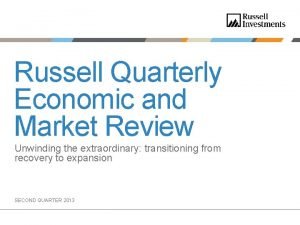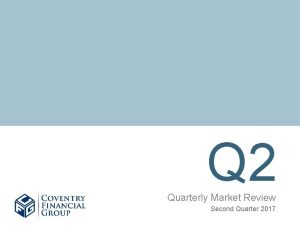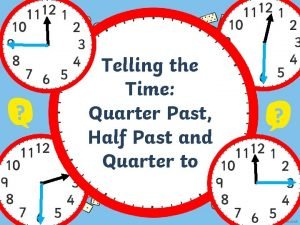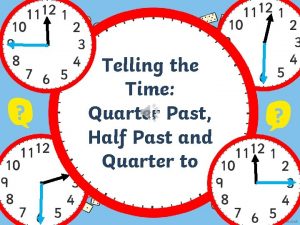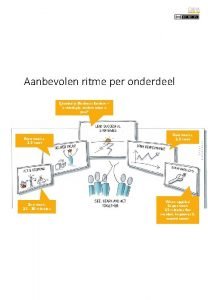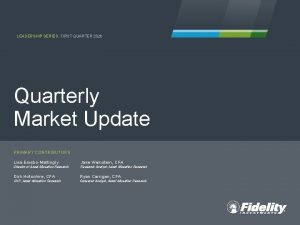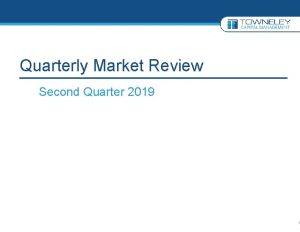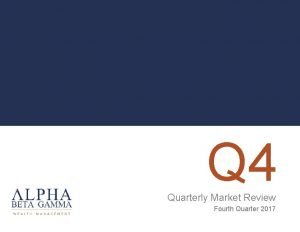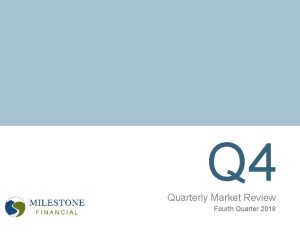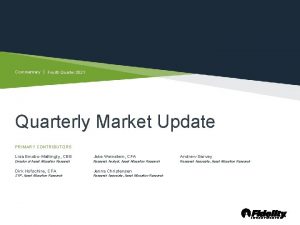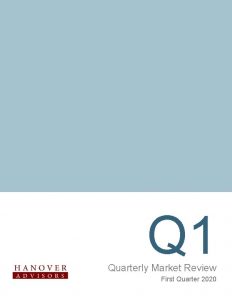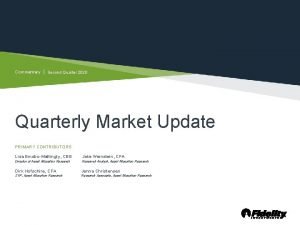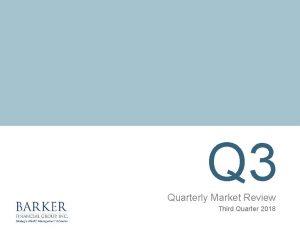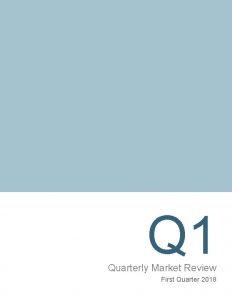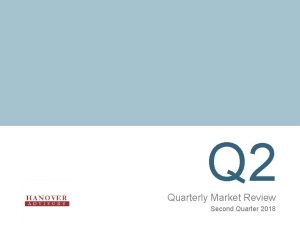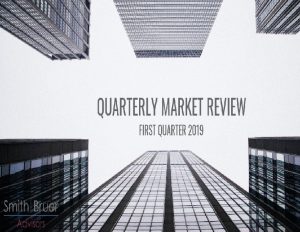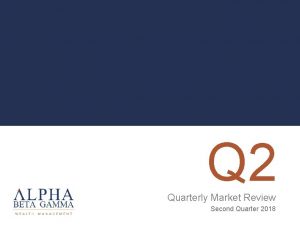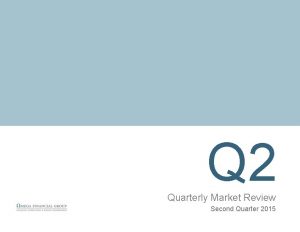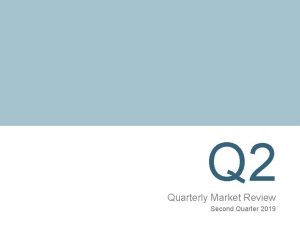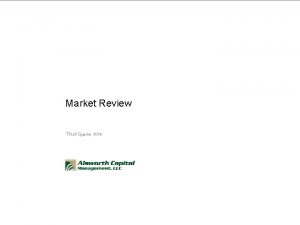Q 4 Quarterly Market Review Fourth Quarter 2020
























- Slides: 24

Q 4 Quarterly Market Review Fourth Quarter 2020

Quarterly Market Review Fourth Quarter 2020 This report features world capital market performance and a timeline of events for the past quarter. It begins with a global overview, then features the returns of stock and bond asset classes in the US and international markets. The report also illustrates the impact of globally diversified portfolios and features a quarterly topic. Overview: Market Summary World Stock Market Performance World Asset Classes US Stocks International Developed Stocks Emerging Markets Stocks Select Market Performance Select Currency Performance vs. US Dollar Real Estate Investment Trusts (REITs) Commodities Fixed Income Global Fixed Income Impact of Diversification Market Review 2020: Looking Back on an Unprecedented Year 2

Quarterly Market Summary Index Returns Past performance is not a guarantee of future results. Indices are not available for direct investment. Index performance does not reflect the expenses associated with the management of an actual portfolio. Market segment (index representation) as follows: US Stock Market (Russell 3000 Index), International Developed Stocks (MSCI World ex USA Index [net div. ]), Emerging Markets (MSCI Emerging Markets Index [net div. ]), Global Real Estate (S&P Global REIT Index [net div. ]), US Bond Market (Bloomberg Barclays US Aggregate Bond Index), and Global Bond Market ex US (Bloomberg Barclays Global Aggregate ex-USD Bond Index [hedged to USD]). S&P data © 2021 S&P Dow Jones Indices LLC, a division of S&P Global. All rights reserved. Frank Russell Company is the source and owner of the trademarks, service marks, and copyrights related to the Russell Indexes. MSCI data © MSCI 2021, all rights reserved. Bloomberg Barclays data provided by Bloomberg. 3

Long-Term Market Summary Index Returns as of December 31, 2020 Past performance is not a guarantee of future results. Indices are not available for direct investment. Index performance does not reflect the expenses associated with the management of an actual portfolio. Market segment (index representation) as follows: US Stock Market (Russell 3000 Index), International Developed Stocks (MSCI World ex USA Index [net div. ]), Emerging Markets (MSCI Emerging Markets Index [net div. ]), Global Real Estate (S&P Global REIT Index [net div. ]), US Bond Market (Bloomberg Barclays US Aggregate Bond Index), and Global Bond Market ex US (Bloomberg Barclays Global Aggregate ex-USD Bond Index [hedged to USD]). S&P data © 2021 S&P Dow Jones Indices LLC, a division of S&P Global. All rights reserved. Frank Russell Company is the source and owner of the trademarks, service marks, and copyrights related to the Russell Indexes. MSCI data © MSCI 2021, all rights reserved. Bloomberg Barclays data provided by Bloomberg. 4

World Stock Market Performance MSCI All Country World Index with selected headlines from Q 4 2020 340 320 300 280 260 240 220 200 сен 30 окт 30 ноя 30 дек 30 “US Jobless “Dow “Powell Says Claims “Brexit Eclipses Fed Actions Reach Trade 30000 for Unlocked $2 Three. Deal First Time” Trillion to Month High” Reached “US Industrial Support Between Production Economy” UK, EU” “Joe Biden’s Rose 1. 1% in “President Victory Affirmed October” Trump “UK Office for “Stricter Lockdowns by Electoral Signs Budget Reimposed in College” Package Responsibility “China Economy Europe” “Oil Prices Tumble For Virus Sees Economy Grows 4. 9% as as New Relief” Shrinking 11. 3%” Rest of World “US Stocks Coronavirus “US Household Net “US Economy Struggles With Notch Records Strain Sparks Worth Hits Record Recovered Significant Coronavirus” in Final Trading Travel in Third Quarter” Ground in Record Third Day of 2020” Restrictions” -Quarter Rebound” “Global Outlook Brightens as US “US Home Consumer Imports Sales Rise Reach Preto New 14 Pandemic Levels” “US Budget Gap Year High” Tripled to “US Job Gains Record $3. 1 Slow as Layoffs Trillion in Fiscal Persist” 2020” These headlines are not offered to explain market returns. Instead, they serve as a reminder that investors should view daily events from a long-term perspective and avoid making investment decisions based solely on the news. Graph Source: MSCI ACWI Index [net div. ]. MSCI data © MSCI 2021, all rights reserved. It is not possible to invest directly in an index. Performance does not reflect the expenses associated with management of an actual portfolio. Past performance is not a guarantee of future results. 5

World Stock Market Performance MSCI All Country World Index with selected headlines from past 12 months LONG TERM (2000–Q 4 2020) 340 240 SHORT TERM (Q 4 2019–Q 4 2020) Last 12 months 140 340 40 2005 2010 2015 2020 300 280 260 240 220 200 180 дек 31 мар 31 июн 30 сен 30 дек 30 “Dow Eclipses “Eurozone Economy “Oil Prices 30000 for First Sees Largest “Dow Closes Time” Contraction on “US Stocks at Record as Collapse “US Debt Hits “Joe Biden’s After Record” Close Out Best Worries Postwar “US Home Victory Affirmed Saudi “At Least a Quarter Since Abate” Record” Sales Rise by Electoral Pledge to Fourth of US “New Virus Discovered by 1998” “Fed Eases to New 14 - College” Boost Economy Goes Chinese Scientists “Recession in US Inflation Target Year High” “Brexit Trade Output” Idle from Investigating Pneumonia Began in February, in Landmark Deal Reached “Record Rise in Lockdown” Outbreak” Ending 128 -month Decision” Between UK, “US Stocks Finish Unemployment Claims Expansion” EU” Second Straight Halts Historic Run of Job “Dow, S&P, Nasdaq All “Consumer Quarter of Big Growth” Drop More than 4% in “US Stocks Notch Spending Rose Gains” Largest One-Day Point Records in Final Trading 5. 6% in June” Declines on Record” Day of 2020” These headlines are not offered to explain market returns. Instead, they serve as a reminder that investors should view daily events from a long-term perspective and avoid making investment decisions based solely on the news. Graph Source: MSCI ACWI Index [net div. ]. MSCI data © MSCI 2021, all rights reserved. It is not possible to invest directly in an index. Performance does not reflect the expenses associated with management of an actual portfolio. Past performance is not a guarantee of future results. 6

World Asset Classes Fourth Quarter 2020 Index Returns (%) Equity markets around the globe posted positive returns in the fourth quarter. Looking at broad market indices, emerging markets outperformed non-US developed markets and US equities. Value outperformed growth across regions. Small caps outperformed large caps across regions as well. REIT indices underperformed equity market indices in both the US and non-US developed markets. Russell 2000 Value Index 33, 36 Russell 2000 Index 31, 37 MSCI Emerging Markets Value Index (net div. ) 22, 98 MSCI Emerging Markets Small Cap Index (net div. ) 22, 22 MSCI Emerging Markets Index (net div. ) 19, 70 MSCI World ex USA Value Index (net div. ) 19, 30 MSCI World ex USA Small Cap Index (net div. ) 17, 55 MSCI All Country World ex USA Index (net div. ) 17, 01 Russell 1000 Value Index 16, 25 MSCI World ex USA Index (net div. ) 15, 85 S&P Global ex US REIT Index (net div. ) 15, 03 Russell 3000 Index 14, 68 Russell 1000 Index 13, 69 Dow Jones US Select REIT Index 12, 92 S&P 500 Index Bloomberg Barclays US Aggregate Bond Index 12, 15 0, 67 One-Month US Treasury Bills 0, 02 Past performance is not a guarantee of future results. Indices are not available for direct investment. Index performance does not reflect the expenses associated with the management of an actual portfolio. The S&P data is provided by Standard & Poor's Index Services Group. Frank Russell Company is the source and owner of the trademarks, service marks, and copyrights related to the Russell Indexes. MSCI data © MSCI 2021, all rights reserved. Dow Jones data © 2021 S&P Dow Jones Indices LLC, a division of S&P Global. All rights reserved. S&P data © 2021 S&P Dow Jones Indices LLC, a division of S&P Global. All rights reserved. Bloomberg Barclays data provided by Bloomberg. Treasury bills © Stocks, Bonds, Bills, and Inflation Yearbook™, Ibbotson Associates, Chicago (annually updated work by Roger G. Ibbotson and Rex A. Sinquefield). 7

US Stocks Fourth Quarter 2020 Index Returns The US equity market posted positive returns for the quarter Ranked Returns (%) but underperformed non-US developed markets and emerging markets. Small Value outperformed growth across large and small cap stocks. Small Cap Small caps outperformed large caps. 33, 36 31, 37 Small Growth 29, 61 Large Value 16, 25 REIT indices underperformed equity market indices. Marketwide Large Cap Large Growth World Market Capitalization—US 14, 68 13, 69 11, 39 Period Returns (%) 56% US Market $37. 9 trillion Past performance is not a guarantee of future results. Indices are not available for direct investment. Index performance does not reflect the expenses associated with the management of an actual portfolio. Market segment (index representation) as follows: Marketwide (Russell 3000 Index), Large Cap (Russell 1000 Index), Large Cap Value (Russell 1000 Value Index), Large Cap Growth (Russell 1000 Growth Index), Small Cap (Russell 2000 Index), Small Cap Value (Russell 2000 Value Index), and Small Cap Growth (Russell 2000 Growth Index). World Market Cap represented by Russell 3000 Index, MSCI World ex USA IMI Index, and MSCI Emerging Markets IMI Index. Russell 3000 Index is used as the proxy for the US market. Dow Jones US Select REIT Index used as proxy for the US REIT market. Frank Russell Company is the source and owner of the trademarks, service marks, and copyrights related to the Russell Indexes. MSCI data © MSCI 2021, all rights reserved. 8

International Developed Stocks Fourth Quarter 2020 Index Returns Developed markets outside the US posted positive returns for Ranked Returns (%) Local currency the quarter, outperforming US equities but underperforming emerging markets. US currency 14, 32 Value 19, 30 Value outperformed growth. Small caps outperformed large caps. 12, 32 Small Cap 17, 55 11, 10 Large Cap 15, 85 Growth 8, 10 12, 63 World Market Capitalization—International Developed Period Returns (%) 30% International Developed Market $20. 5 trillion Past performance is not a guarantee of future results. Indices are not available for direct investment. Index performance does not reflect the expenses associated with the management of an actual portfolio. Market segment (index representation) as follows: Large Cap (MSCI World ex USA Index), Small Cap (MSCI World ex USA Small Cap Index), Value (MSCI World ex USA Value Index), and Growth (MSCI World ex USA Growth Index). All index returns are net of withholding tax on dividends. World Market Cap represented by Russell 3000 Index, MSCI World ex USA IMI Index, and MSCI Emerging Markets IMI Index. MSCI World ex USA IMI Index is used as the proxy for the International Developed market. MSCI data © MSCI 2021, all rights reserved. Frank Russell Company is the source and owner of the trademarks, service marks, and copyrights related to the Russell Indexes. 9

Emerging Markets Stocks Fourth Quarter 2020 Index Returns Emerging markets posted positive returns for the quarter, Ranked Returns (%) Local currency US currency outperforming the US and developed ex US equity markets. Value outperformed growth. 18, 91 Value 22, 98 Small caps outperformed large caps. 17, 22 Small Cap 22, 22 16, 02 Large Cap 19, 70 Growth 13, 48 16, 83 World Market Capitalization—Emerging Markets Period Returns (%) 13% Emerging Markets $8. 8 trillion Past performance is not a guarantee of future results. Indices are not available for direct investment. Index performance does not reflect the expenses associated with the management of an actual portfolio. Market segment (index representation) as follows: Large Cap (MSCI Emerging Markets Index), Small Cap (MSCI Emerging Markets Small Cap Index), Value (MSCI Emerging Markets Value Index), and Growth (MSCI Emerging Markets Growth Index). All index returns are net of withholding tax on dividends. World Market Cap represented by Russell 3000 Index, MSCI World ex USA IMI Index, and MSCI Emerging Markets IMI Index used as the proxy for the emerging market portion of the market. MSCI data © MSCI 2021, all rights reserved. Frank Russell Company is the source and owner of the trademarks, service marks, and copyrights related to the Russell Indexes. 10

Select Market Performance Fourth Quarter 2020 Index Returns In US dollar terms, Austria and Spain recorded the highest country performance in developed markets, while Switzerland Finland posted the lowest returns for the quarter. In emerging markets, Colombia and Hungary recorded the highest country performance, while Egypt and Kuwait posted the lowest performance. Ranked Developed Markets Returns (%) Austria Spain Norway Australia Israel Italy Portugal France Netherlands New Zealand UK Singapore Belgium Ireland Hong Kong Sweden Canada US Denmark Japan Germany Finland Switzerland Ranked Emerging Markets Returns (%) 38, 67 27, 25 24, 09 22, 78 21, 87 21, 26 21, 14 20, 42 19, 30 19, 29 18, 60 16, 77 16, 48 16, 01 15, 20 15, 05 14, 80 14, 68 14, 43 14, 03 12, 33 11, 88 8, 70 Colombia Hungary Brazil Korea Indonesia Czech Republic Greece Turkey Mexico Peru Chile Argentina Thailand Philippines South Africa Taiwan Russia India Poland Malaysia China UAE Pakistan Saudi Arabia Qatar Kuwait Egypt -2, 41 47, 45 37, 71 36, 43 36, 42 35, 35 34, 30 32, 96 32, 91 31, 12 29, 85 26, 91 25, 45 24, 89 23, 48 23, 07 22, 11 21, 40 20, 94 17, 11 11, 44 11, 38 11, 02 9, 30 6, 50 2, 22 1, 31 Past performance is not a guarantee of future results. Indices are not available for direct investment. Index performance does not reflect the expenses associated with the management of an actual portfolio. MSCI Index returns are in USD net of dividend withholding taxes. Country returns are the country component indices of the MSCI All Country World ex USA IMI for all countries except the United States, where the Russell 3000 index is used instead. Frank Russell Company is the source and owner of the trademarks, service marks and copyrights related to the Russell Indexes. MSCI data © MSCI 2021, all rights reserved. Indices are not available for direct investment. Their performance does not reflect the expenses associated with the management of an actual portfolio. Past performance is not a guarantee of future results. 11

Select Currency Performance vs. US Dollar Fourth Quarter 2020 In developed markets, most currencies appreciated versus the US dollar. In emerging markets, most currencies appreciated versus the US dollar, but some, notably the Argentinian peso, depreciated. Ranked Developed Markets (%) Ranked Emerging Markets (%) Norwegian krone (NOK) 9, 28 Swedish krona (SEK) 8, 98 New Zealand dollar (NZD) 8, 93 Australian dollar (AUD) 7, 66 Israeli New shekel (ILS) 6, 52 British pound (GBP) 5, 74 Canadian dollar (CAD) 4, 85 Danish krone (DKK) 4, 34 Euro (EUR) 4, 34 Swiss franc (CHF) 3, 94 Singapore dollar (SGD) 3, 29 Japanese yen (JPY) Hong Kong dollar (HKD) 2, 21 -0, 05 South African rand (ZAR) Colombian peso (COP) Chilean peso (CLP) Mexican peso (MXN) Brazilian real (BRL) Korean won (KRW) Czech koruna (CZK) Indonesian rupiah (IDR) Thai baht (THB) Russian ruble (RUB) Hungarian forint (HUF) Chinese renminbi (CNY) Polish zloty (PLN) Pakistani rupee (PKR) Turkish lira (TRY) Malaysian ringgit (MYR) New Taiwan dollar (TWD) Indian rupee (INR) Philippine peso (PHP) Kuwait dinar (KWD) Egyptian pound (EGP) Saudi Arabian riyal (SAR) Peruvian sol (PEN) Argentinian peso (ARS) -9, 39 13, 56 12, 68 10, 88 10, 79 8, 51 7, 66 7, 62 5, 91 5, 77 4, 92 4, 48 4, 14 3, 77 3, 72 3, 65 3, 31 3, 07 0, 98 0, 95 0, 76 0, 19 -0, 02 -0, 56 Past performance is not a guarantee of future results. Indices are not available for direct investment. Index performance does not reflect the expenses associated with the management of an actual portfolio. MSCI data © MSCI 2021, all rights reserved. 12

Real Estate Investment Trusts (REITs) Fourth Quarter 2020 Index Returns US real estate investment trusts underperformed non-US Ranked Returns (%) REITs during the quarter. Global ex US REITS Total Value of REIT Stocks 40% World ex US $510 billion 278 REITs (25 other countries) 15, 03 12, 92 Period Returns (%) 60% US $767 billion 115 REITs Past performance is not a guarantee of future results. Indices are not available for direct investment. Index performance does not reflect the expenses associated with the management of an actual portfolio. Number of REIT stocks and total value based on the two indices. All index returns are net of withholding tax on dividends. Total value of REIT stocks represented by Dow Jones US Select REIT Index and the S&P Global ex US REIT Index. Dow Jones US Select REIT Index used as proxy for the US market, and S&P Global ex US REIT Index used as proxy for the World ex US market. Dow Jones and S&P data © 2021 S&P Dow Jones Indices LLC, a division of S&P Global. All rights reserved. 13

Commodities Fourth Quarter 2020 Index Returns The Bloomberg Commodity Index Total Return returned Ranked Returns (%) 10. 19% for the fourth quarter of 2020. Soybean Oil Soybean oil and soybeans were the best performers, gaining 28. 42% and 27. 39%, respectively. Natural gas and live cattle were the worst performers, declining 18. 84% and 0. 43%, respectively. 28, 42 Soybean 27, 39 Soybean Meal 25, 63 Heating Oil 25, 56 Corn 25, 13 Low Sulphur Gas. . . 22, 94 Unleaded Gas 20, 99 Brent Crude Oil 19, 42 WTI Crude Oil 18, 15 Kansas Wheat 16, 69 Copper 15, 80 Cotton Period Returns (%) 15, 66 Sugar 14, 66 Nickel 14, 06 Zinc 13, 56 Coffee 12, 76 Aluminum 12, 02 Silver 11, 78 Wheat 9, 36 Lean Hogs 8, 71 Gold -0, 38 Live Cattle -0, 43 Natural Gas -18, 84 Past performance is not a guarantee of future results. Index is not available for direct investment. Index performance does not reflect the expenses associated with the management of an actual portfolio. Commodities returns represent the return of the Bloomberg Commodity Total Return Index. Individual commodities are sub-index values of the Bloomberg Commodity Total Return Index. Data provided by Bloomberg. 14

Fixed Income Fourth Quarter 2020 Index Returns Interest rate changes were mixed in the US US Treasury Yield Curve (%) Treasury fixed income market during the fourth quarter of 2020. The yield on the 5 Year US Treasury note increased 8 basis 4, 00 points (bps), ending at 0. 39%. The yield on the 10 -Year Treasury increased 29 bps to 0. 93%. The 30 -Year US Treasury bond yield increased 18 bps to finish at 1. 64%. Bond Yield across Issuers (%) 2, 24 1, 88 3, 00 1, 47 43830 2, 00 44196 44104 0, 93 1, 00 On the short end of the yield curve, the 1 Month US Treasury bill yield remained unchanged at 0. 08%, while the 1 -Year US T-bill yield decreased 1 bps to 0. 13%. The 2 -Year US Treasury note yield finished unchanged at 0. 09%. 0, 00 1 Yr 5 Yr 10 Yr 30 Yr 10 -Year US Treasury State and Local Municipals AAA-AA Corporates A-BBB Corporates Period Returns (%) In terms of total returns, short-term corporate bonds added 1. 14%. Intermediate-term corporate bonds returned 1. 76%. The total return for short-term municipal bonds was 0. 44%, while intermediate-term munis returned 1. 36%. Revenue bonds outperformed general obligation bonds. One basis point (bps) equals 0. 01%. Past performance is not a guarantee of future results. Indices are not available for direct investment. Index performance does not reflect the expenses associated with the management of an actual portfolio. Yield curve data from Federal Reserve. State and local bonds are from the S&P National AMT-Free Municipal Bond Index. AAA-AA Corporates represent the Bank of America Merrill Lynch US Corporates, AA-AAA rated. A-BBB Corporates represent the ICE Bof. A Corporates, BBB-A rated. Bloomberg Barclays data provided by Bloomberg. US long-term bonds, bills, inflation, and fixed income factor data © Stocks, Bonds, Bills, and Inflation (SBBI) Yearbook™, Ibbotson Associates, Chicago (annually updated work by Roger G. Ibbotson and Rex A. Sinquefield). FTSE fixed income indices © 2021 FTSE Fixed Income LLC, all rights reserved. ICE Bof. A index data © 2021 ICE Data Indices, LLC. S&P data © 2021 S&P Dow Jones Indices LLC, a division of S&P Global. All rights reserved. 15

Global Fixed Income Fourth Quarter 2020 Yield Curves US UK 4, 0 rates in the global developed markets were mixed for the quarter. 3, 0 Longer-term bonds generally outperformed shorter-term bonds in global ex-US developed markets. 2, 0 12/31/2020 9/30/2020 1, 0 0, 0 Yield (%) 4, 0 Yield (%) Changes in government bond interest -1, 0 2, 0 12/31/2020 9/30/2020 1, 0 0, 0 -1, 0 1 Y 10 Y 1 Y Years to Maturity Germany Japan 4, 0 3, 0 2, 0 1, 0 9/30/2020 12/31/2020 0, 0 Yield (%) Short- and intermediate-term nominal interest rates were negative in Japan, while all maturities finished in negative territory in Germany. -1, 0 12/31/2020 9/30/2020 0, 0 -1, 0 1 Y 10 Y 1 Y Years to Maturity 10 Y Years to Maturity Canada Australia 4, 0 3, 0 2, 0 12/31/2020 9/30/2020 1, 0 0, 0 -1, 0 Yield (%) 10 Y 12/31/2020 9/30/2020 2, 0 1, 0 0, 0 -1, 0 1 Y 10 Y Years to Maturity One basis point (bps) equals 0. 01%. Source: ICE Bof. A government yield. ICE Bof. A index data © 2021 ICE Data Indices, LLC. 1 Y 10 Y Years to Maturity 16

Impact of Diversification Fourth Quarter 2020 These portfolios illustrate the performance of different global stock/bond mixes and highlight the benefits of diversification. Mixes with larger allocations to stocks are considered riskier but have higher expected returns over time. Ranked Returns (%) 100% Stocks 14, 79 75/25 11, 07 50/50 7, 37 25/75 100% Treasury Bills 3, 69 0, 02 Growth of Wealth: The Relationship between Risk and Return Stock/Bond Mix $140 000 100% Stocks $120 000 Period Returns (%) 75/25 $100 000 $80 000 50/50 $60 000 25/75 $40 000 100% Treasury Bills $20 000 $0 12. 1988 12. 1993 12. 1998 12. 2003 12. 2008 12. 2013 12. 2018 1. STDEV (standard deviation) is a measure of the variation or dispersion of a set of data points. Standard deviations are often used to quantify the historical return volatility of a security or portfolio. Diversification does not eliminate the risk of market loss. Past performance is not a guarantee of future results. Indices are not available for direct investment. Index performance does not reflect expenses associated with the management of an actual portfolio. Asset allocations and the hypothetical index portfolio returns are for illustrative purposes only and do not represent actual performance. Global Stocks represented by MSCI All Country World Index (gross div. ) and Treasury Bills represented by US One-Month Treasury Bills. Globally diversified allocations rebalanced monthly, no withdrawals. Data © MSCI 2021, all rights reserved. Treasury bills © Stocks, Bonds, Bills, and Inflation Yearbook™, Ibbotson Associates, Chicago (annually updated work by Roger G. Ibbotson and Rex A. Sinquefield). 17

Market Review 2020: Looking Back on an Unprecedented Year Fourth Quarter 2020 The year 2020 proved to be one of the most tumultuous in modern history, marked by a number of developments that were historically unprecedented. But the year also demonstrated the resilience of people, institutions, and financial markets. The novel coronavirus was already in the news early in the year, and concerns grew as more countries began reporting their first cases of COVID-19. Infections multiplied around the world through February, and by early March, when the outbreak was labeled a pandemic, it was clear that the crisis would affect nearly every area of our lives. The spring would see a spike in cases and a global economic contraction as people stayed closer to home, and another surge of infections would come during the summer. Governments and central banks worked to cushion the blow, providing financial support for individuals and businesses and adjusting lending rates. over the pandemic, global stock market returns in 2020 were above their historical norm. The US market finished the year in record territory and with an 18. 40% annual return for the S&P 500 Index. Non-US developed markets, as measured by the MSCI World ex USA Index, 2 returned 7. 59%. Emerging markets, as measured by the MSCI Emerging Markets Index, returned 18. 31% for the year. Exhibit 1. Highs and Lows MSCI All Country World Index with selected headlines from 2020 On top of the health crisis, there was widespread civil unrest over the summer in the US tied to policing and racial justice. In August, Americans increasingly focused on the US presidential race in this unusual year. Politicians, supporters, and voting officials wrestled with the challenges of a campaign that at times was conducted virtually and with an election in the fall that would include a heightened level of mail-in and early voting. In the end, the results of the election would be disputed well into December. As autumn turned to winter, 2020 would end with both troubling and hopeful news: yet another spike in COVID-19 cases, along with the first deliveries of vaccines in the US and elsewhere. For investors, the year was characterized by sharp swings for stocks. March saw a 33. 79% drop in the S&P 500 Index 1 as the pandemic worsened. This was followed by a rally in April, and stocks reached their previous highs by August. Ultimately, despite a sequence of epic events and continued concerns Past performance is no guarantee of future results. In US dollars, net dividends. MSCI data © MSCI 2021, all rights reserved. Indices are not available for direct investment. Index returns are not representative of actual portfolios and do not reflect costs and fees associated with an actual investment. 1. S&P data © 2021 S&P Dow Jones Indices LLC, a division of S&P Global. All rights reserved. Indices are not available for direct investment. 2. MSCI data © MSCI 2021, all rights reserved. Indices are not available for direct investment. 18

Market Review 2020 (continued from page 18) Fixed income markets mirrored the extremity of equity behavior, with nearly unprecedented dispersion in returns during the first half of 2020. For example, in the first quarter, US corporate bonds underperformed US Treasuries by more than 11%, the most negative quarterly return difference in data going back a half century. But they soon swapped places: the second quarter was the secondmost positive on record for corporates over Treasuries, with a 7. 74% advantage. 3 Large return deviations were also observed between US and non. US fixed income as well as between inflation-protected and nominal bonds. Global yield curves finished the year generally lower than at the start. US Treasury yields, for example, fell across the board, with drops of more than 1% Exhibit 2. Sharp Shifts US Credit minus US Treasury: Quarterly Returns, March 1973–December 2020 Past performance is no guarantee of future results. In US dollars. US credit represented by the Bloomberg Barclays US Credit Bond Index. US Treasuries represented by the Bloomberg Barclays US Treasury Bond Index. Bloomberg Barclays data provided by Bloomberg. Indices are not available for direct investment. Index returns are not representative of actual portfolios and do not reflect costs and fees associated with an actual investment. 3. 4. 5. on the short and intermediate portions of the curve. 4 The US Treasury curve ended relatively flat in the short-term segment but upwardly sloped from the intermediate- to long-term segment. For 2020, the Bloomberg Barclays Global Aggregate Bond Index returned 5. 58%. 5 Uncertainty remains about the pandemic and the broad impact of the new vaccines, continued lockdowns, and social distancing. But the events of 2020 provided investors with many lessons, affirming that following a disciplined and broadly diversified investment approach is a reliable way to pursue long-term investment goals. MARKET PRICES QUICKLY REFLECT NEW INFORMATION ABOUT THE FUTURE The fluctuating markets in the spring and summer were also a lesson in how markets incorporate new information and changes in expectations. From its peak on February 19, 2020, the S&P 500 Index fell 33. 79% in less than five weeks as the news headlines suggested more extreme outcomes from the pandemic. But the recovery would be swift as well. Market participants were watching for news that would provide insights into the pandemic and the economy, such as daily infection and mortality rates, effective therapeutic treatments, and the potential for vaccine development. As more information became available, the S&P 500 Index jumped 17. 57% from its March 23 low in just three trading sessions, one of the fastest snapbacks on record. This period highlighted the vital role of data in setting market expectations and underscored how quickly prices adjust to new information. One major theme of the year was the perceived disconnect between markets and the economy. How could the equity markets recover and reach new highs when the economic news remained so bleak? The market’s behavior suggests investors were looking past the short-term impact of the pandemic to assess the expected rebound of business activity and an eventual return to US corporate bonds represented by the Bloomberg Barclays US Credit Bond Index. US Treasuries represented by the Bloomberg Barclays US Treasury Bond Index. Bloomberg Barclays data provided by Bloomberg. Indices are not available for direct investment. ICE Bof. A government yield. ICE Bof. A index data © 2021 ICE Data Indices, LLC. Bloomberg Barclays data provided by Bloomberg. All rights reserved. Indices are not available for direct investment. 19

Market Review 2020 (continued from page 19) more-normal conditions. Seen through that lens, the rebound in share prices reflected a market that is always looking ahead, incorporating both current news and expectations of the future into stock prices. Then, over the six-month period from April 1 to September 30, global equities and fixed income returned 29. 54% and 3. 16%, respectively. A move to cash in March may have been a costly decision for anxious investors. OWNING THE WINNERS AND LOSERS It was important for investors to avoid reacting to the dispersion in performance between asset classes, too, lest they miss out on turnarounds from early in the year to later. For example, small cap stocks on the whole fared better in the second half of the year than the first. The stark difference in performance The 2020 economy and market also underscored the importance of staying broadly diversified across companies and industries. The downturn in stocks impacted some segments of the market more than others in ways that were consistent with the impact of the COVID-19 pandemic on certain types of businesses or industries. For example, airline, hospitality, and retail industries tended to suffer disproportionately with people around the world staying at home, whereas companies in communications, online shopping, and technology emerged as relative winners during the crisis. However, predicting at the beginning of 2020 exactly how this might play out would likely have proved challenging. Exhibit 3. Cash Concerns in 2020 In the end, the economic turmoil inflicted great hardship on some firms while creating economic and social conditions that provided growth opportunities for other companies. In any market, there will be winners and losers—and investors have historically been well served by owning a broad range of companies rather than trying to pick winners and losers. STICKING WITH YOUR PLAN Many news reports rightly emphasized the unprecedented nature of the health crisis, the emergency financial actions, and other extraordinary events during 2020. The year saw many “firsts”—and subsequent years will doubtless usher in many more. Yet 2020’s outcomes remind us that a consistent investment approach is a reliable path regardless of the market events we encounter. Investors who made moves by reacting to the moment may have missed opportunities. In March, spooked investors fled the stock and bond markets, as money-market funds experienced net flows for the month totaling $684 billion. Past performance is no guarantee of future results. In US dollars. Global equity returns is the MSCI All Country World IMI Index (net div. ). MSCI data © MSCI 2021, all rights reserved. Money market fund flows provided by Morningstar. Indices are not available for direct investment. Index returns are not representative of actual portfolios and do not reflect costs and fees associated with an actual investment. 20

Market Review 2020 (continued from page 20) A WELCOME TURN OF THE CALENDAR Moving into 2021, many questions remain about the pandemic, new vaccines, business activity, changes in how people work and socialize, and the direction of global markets. Yet 2020’s economic and market tumult demonstrated that markets continue to function and that people can adapt to difficult circumstances. The year’s positive equity and fixed income returns remind that, with a solid investment approach and a commitment to staying the course, investors can focus on building long-term wealth, even in challenging times. The information in this document is provided in good faith without any warranty and is intended for the recipient’s background information only. It does not constitute investment advice, recommendation, or an offer of any services or products for sale and is not intended to provide a sufficient basis on which to make an investment decision. It is the responsibility of any persons wishing to make a purchase to inform themselves of and observe all applicable laws and regulations. Unauthorized copying, reproducing, duplicating, or transmitting of this document are strictly prohibited. Dimensional accepts no responsibility for loss arising from the use of the information contained herein. “Dimensional” refers to the Dimensional separate but affiliated entities generally, rather than to one particular entity. These entities are Dimensional Fund Advisors LP, Dimensional Fund Advisors Ltd. , Dimensional Ireland Limited, DFA Australia Limited, Dimensional Fund Advisors Canada ULC, Dimensional Fund Advisors Pte. Ltd, Dimensional Japan Ltd. , and Dimensional Hong Kong Limited is licensed by the Securities and Futures Commission to conduct Type 1 (dealing in securities) regulated activities only and does not provide asset management services. Dimensional Fund Advisors LP is an investment advisor registered with the Securities and Exchange Commission. 21

Disclosures A basis point is the smallest measure used in quoting yields or interest rates. One basis point is equal to one-hundredth of one percentage point (0. 01%). There is no guarantee that a diversified portfolio will enhance overall returns or outperform a non-diversified portfolio. Diversification does not protect against market risk. Bonds are subject to market and interest rate risk if sold prior to maturity. Bond values will decline as interest rates rise and bonds are subject to availability and change in price. Bond yields are subject to change. Certain call or special redemption features may exist which could impact yield. The price of equity securities may rise or fall because of changes in the broad market or changes in a company’s financial condition, sometimes rapidly or unpredictably. These price movements may result from factors affecting individual companies, sectors or industries, or the securities market as a whole, such as changes in economic or political conditions. Equity securities are subject to “stock market risk” meaning that stock prices in general may decline over short or extended periods of time. Investments in emerging markets can be more volatile. As mentioned above, the normal risks of investing in foreign countries are heightened when investing in emerging markets. In addition, the small size of securities markets and the low trading volume may lead to a lack of liquidity, which leads to increased volatility. Also, emerging markets may not provide adequate legal protection for private or foreign investment or private property. Investments in commodities may have greater volatility than investments in traditional securities, particularly if the instruments involve leverage. The value of commodity-linked derivative instruments may be affected by changes in overall market movements, commodity index volatility, changes in interest rates, or factors affecting a particular industry or commodity, such as drought, floods, weather, livestock disease, embargoes, tariffs and international economic, political and regulatory developments. Use of leveraged commoditylinked derivatives creates an opportunity for increased return but, at the same time, creates the possibility for greater loss. Real estate investments may be subject to a higher degree of market risk because of concentration in a specific industry, sector or geographical sector. Real estate investments may be subject to risks including, but not limited to, declines in the value of real estate, risks related to general and economic conditions, changes in the value of the underlying property owned by the trust and defaults by borrower. Investing in Real Estate Investment Trusts (REITs) involves special risks such as potential illiquidity and may not be suitable for all investors. There is no assurance that the investment objectives of this program will be attained. currency exchange rates and differences in accounting and taxation policies outside the U. S. can raise or lower returns. Also, some overseas markets may not be as politically and economically stable as the United States and other nations. Treasury inflation-protected securities (TIPS) help eliminate inflation risk to your portfolio as the principal is adjusted semiannually for inflation based on the Consumer Price Index – while providing a real rate of return guaranteed by the U. S. Government. Treasury Inflation. Protected Securities, or TIPS, are subject to market risk and significant interest rate risk as their longer duration makes them more sensitive to price declines associated with higher interest rates. World Market Capitalization refers to the total dollar market value that a country makes up, as a whole of the global markets. All indexes are unmanaged, and an individual cannot invest directly in an index Unmanaged index returns do not reflect fees, expenses, or sales charges. Index performance is not indicative of the performance of any investment. Past performance is no guarantee of future results. Russell 1000 Index consists of the 1, 000 largest securities in the Russell 3000 Index, which represents approximately 90% of the total market capitalization of the Russell 3000 Index. It is a large-cap, market-oriented index and is highly correlated with the S&P 500 Index. Russell 2000 Index ® measures the performance of the 2, 000 smallest companies in the Russell 3000 Index® measures the performance of the 3, 000 largest U. S. companies based on total market capitalization. Russell 1000 Value Index ® measures the performance of the large-cap value segment of the U. S. equity universe. It includes those Russell 1000 companies with lower price-to-book ratios and lower expected growth values. The index is unmanaged, includes the reinvestment of dividends and cannot be purchased directly by investors. Russell 2000 Value Index ® measures the performance of those Russell 2000 companies with lower price-to-book ratios and lower forecasted growth values. Russell 3000® Growth Index measures the performance of those Russell 3000 Index companies with higher price-to-book ratios and higher forecasted growthvalues. The stocks in this index are also members of either the Russell 1000 Growthor the Russell 2000 Growth indexes. International investing involves a greater degree of risk and increased volatility. Changes in 22

Disclosures MSCI World ex USA Index captures large and mid cap representation across 22 of 23 Developed Markets (DM) countries*--excluding the United States. With 1, 005 constituents, the index covers approximately 85% of the free float-adjusted market capitalization in each country. MSCI World ex USA Small Cap Index captures small cap representation across 22 of 23 Developed Markets (DM) countries* (excluding the United States). With 2, 437 constituents, the index covers approximately 14% of the free float-adjusted market capitalization in each country. MSCI Emerging Markets Small Cap Index includes small cap representation across 23 Emerging Markets countries*. With 1, 792 constituents, the index covers approximately 14% of the free float-adjusted market capitalization in each country. The small cap segment tends to capture more local economic and sector characteristics relative to larger Emerging Markets capitalization segments. MSCI World ex USA Value Index captures large and mid cap securities exhibiting overall value style characteristics across 22 of 23 Developed Markets countries*. The value investment style characteristics for index construction are defined using three variables: book value to price, 12 -month forward earnings to price and dividend yield. With 540 constituents, the index targets 50% coverage of the free float-adjusted market capitalization of the MSCI World ex USA Index. MSCI Emerging Markets Value Index captures large and mid cap securities exhibiting overall value style characteristics across 23 Emerging Markets (EM) countries*. The value investment style characteristics for index construction are defined using three variables: book value to price, 12 -month forward earnings to price and dividend yield. With 484 constituents, the index targets 50% coverage of the free float-adjusted market capitalization of the MSCI EM Index. MSCI Emerging Markets Index captures large and mid cap representation across 24 Emerging Markets (EM) countries*. With 1, 125 constituents, the index covers approximately 85% of the free float-adjusted market capitalization in each country. MSCI Emerging Markets Index. SM is a free float-adjusted market capitalization index that is designed to measure equity market performance in the global emerging markets. As of June 2007, the MSCI Emerging Markets Index consisted of the following 25 emerging market country indices: Argentina, Brazil, Chile, China, Colombia, Czech Republic, Egypt, Hungary, India, Indonesia, Israel, Jordan, Korea, Malaysia, Mexico, Morocco, Pakistan, Peru, Philippines, Poland, Russia, South Africa, Taiwan, Thailand, and Turkey. MSCI ACWI (All Country World Index) Index is a free float-adjusted market capitalization weighted index that is designed to measure the equity market performance of developed and emerging markets. As of June 2009 the MSCI ACWI consisted of 45 country indices comprising 23 developed and 22 emerging market country indices. MSCI USA Investable Market Index (IMI) is designed to measure the performance of the large, mid and small cap segments of the US market. With 2, 411 constituents, the index covers approximately 99% of the free float- adjusted market capitalization in the US. MSCI World ex USA Investable Market Index (IMI) captures large, mid and small cap representation across 22 of 23 Developed Markets (DM) countries*--excluding the United States. With 3, 553 constituents, the index covers approximately 99% of the free floatadjusted market capitalization in each country. S&P 500 Index is widely regarded as the best single gauge of the U. S. equities market. This world-renowned index includes a representative sample of 500 leading companies in leading industries of the U. S. economy. Although the S&P 500 Index focuses on the large-cap segment of the market, with approximately 75% coverage of U. S. equities, it is also an ideal proxy for the total market. An investor cannot invest directly in an index. A member of the S&P Global Property Index Series, the S&P Global REIT Index serves as a comprehensive benchmark of publicly traded equity REITs listed in both developed and emerging markets. S&P Global ex-U. S. Property Index defines and measures the investable universe of publicly traded property companies domiciled in developed and emerging markets excluding the U. S. The companies included are engaged in real estate related activities such as property ownership, management, development, rental and investment. S&P/Citigroup International Treasury Bond Ex-U. S. 1 -3 Years Index is designed to reflect the performance of bonds issues by non-U. S. developed market countries maturing in 1 -3 years. Dow Jones U. S. Select REIT Index intends to measure the performance of publicly traded REITs and REIT-like securities. The index is a subset of the Dow Jones U. S. Select Real Estate Securities Index (RESI), which represents equity real estate investment trusts (REITs) and real estate operating companies (REOCs) traded in the U. S. The indices are designed to serve as proxies for direct real estate investment, in part by excluding companies whose performance may be driven by factors other than the value of real estate. 23

Disclosures FTSE World Government Bond Index 1 -5 Years comprises central government debt from 22 Countries (Australia, Austria, Belgium, Canada, Denmark, Finland, France, Germany, Greece, Ireland, Italy, Japan, Netherlands, New Zealand, Norway, Poland, Portugal, Spain, Sweden, Switzerland, UK, and US), denominated in the domicile currency or Euros for Eurozone countries. This particular index has maturity sub-index of 1 to 5 years. FTSE World Government Bond Index 1 -5 Years (hedged to USD) comprises central government debt from 22 Countries (Australia, Austria, Belgium, Canada, Denmark, Finland, France, Germany, Greece, Ireland, Italy, Japan, Netherlands, New Zealand, Norway, Poland, Portugal, Spain, Sweden, Switzerland, UK, and US), denominated in the domicile currency or Euros for Eurozone countries. This particular index has maturity sub-index of 1 to 5 years hedged to US dollar – currencies hedged back to the U. S. dollar (not denominated in domicile currency) Bloomberg Commodity Index is composed of futures contracts on physical commodities and represents twenty-two separate commodities traded on U. S. exchanges, with the exception of aluminum, nickel, and zinc U. S. Treasury Index is a component of the U. S. Government index. Bof. A Merrill Lynch Three-Month US Treasury Bill Index is an unmanaged market index of U. S. Treasury securities maturing in 90 days that assumes reinvestment of all income. Bof. A Merrill Lynch 1 -3 US Year Treasury Index is an unmanaged index that tracks the performance of the direct sovereign debt of the U. S. Government having a maturity of at least one year and less than three years. It is not possible to invest directly in an unmanaged index Citigroup WGBI 1− 5 Years Index measures the performance of the short-term global government bond market. Barclays U. S. Government Index is comprised of the U. S. Treasury and U. S. Agency Indices. The U. S. Government Index includes Treasuries (public obligations of the U. S. Treasury that have remaining maturities of more than one year) and U. S. agency debentures (publicly issued debt of U. S. Government agencies, quasi-federal corporations, and corporate or foreign debt guaranteed by the U. S. Government). The U. S. Government Index is a component of the U. S. Government/Credit Index and the U. S. Aggregate Index. Barclays US Corporate High Yield Bond Index measures the USD-denominated, high yield, fixed-rate corporate bond market. Securities are classified as high yield if the middle rating of Moody’s, Fitch and S&P is Ba 1/BB+ or below. Bonds from issuers with an emerging markets country of risk, based on Barclays EM country definition, are excluded. The US Corporate High Yield Index is a component of the US Universal and Global High Yield Indices. The index was created in 1986, with history backfilled to July 1, 1983. Barclays U. S. Municipal Index covers the USD-denominated long-term tax-exempt bond market. The index has four main sectors: state and local general obligation bonds, revenue bonds, insured bonds, and prerefunded bonds. Many of the sub indices of the Municipal Index have historical data to January 1980. In addition, several sub indices based on maturity and revenue source have been created, some with inception dates after January 1980 but no later than July 1, 1993. In January 1996, Barclays Capital also began publishing a noninvestment grade municipal bond index and "enhanced" state-specific indices for Arizona, Connecticut, Maryland, Massachusetts, Minnesota, and Ohio. These indices are published separately from the Barclays Capital Municipal Bond Index. In 2005, Barclays Capital began publishing Managed Money Municipal Indices and Insurance Mandate Municipal Indices. Barclays US Treasury Index measures US dollar-denominated, fixed-rate, nominal debt issued by the US Treasury bills are excluded by the maturity constraint but are part of a separate Short Treasury Index. STRIPS are excluded from the index because their inclusion would result in double-counting. The US Treasury Index is a component of the US Aggregate, US Universal, Global Aggregate and Global Treasury Indices. The US Treasury Index was launched on January 1, 1973. Barclays US Aggregate Bond Index is a broad-based flagship benchmark that measures the investment grade, US dollar-denominated, fixed-rate taxable bond market. The index includes Treasuries, government-related and corporate securities, MBS (agency fixed-rate and hybrid ARM pass-throughs), ABS and CMBS (agency and non-agency). Provided the necessary inclusion rules are met, US Aggregate eligible securities also contribute to the multi-currency Global Aggregate Index and the US Universal Index, which includes high yield and emerging markets debt. The US Aggregate Index was created in 1986 with history backfilled to January 1, 1976. Bloomberg Barclays Global Aggregate Index i s a measure of global investment grade debt from 24 local currency markets. This multi- currency benchmark includes treasury, government-related, corporate and securitized fixed-rate bonds from both developed and emerging markets issuers. Bloomberg Commodity Total Return index is composed of futures contracts and reflects the returns on a fully collateralized investment in the BCOM. This combines the returns of the BCOM with the returns on cash collateral invested in 13 week (3 Month) U. S. Treasury Bills. 24
 Russell quarterly economic and market review
Russell quarterly economic and market review Russell quarterly economic and market review
Russell quarterly economic and market review Telling time quarter past
Telling time quarter past Quarter past 6
Quarter past 6 Quarterly business review examples
Quarterly business review examples Free quarterly business review template
Free quarterly business review template Quarterly business review templates
Quarterly business review templates Quarterly business review
Quarterly business review Fidelity quarterly market update q1 2018
Fidelity quarterly market update q1 2018 Fourth shift erp system
Fourth shift erp system Market leader challenger follower nicher
Market leader challenger follower nicher Difference between segmentation targeting and positioning
Difference between segmentation targeting and positioning Accesssecure pak
Accesssecure pak Gantt chart quarterly template
Gantt chart quarterly template Key performance index template
Key performance index template Early childhood research quarterly impact factor
Early childhood research quarterly impact factor Steps for computing grades
Steps for computing grades Experian
Experian Wv doc quarterly package program
Wv doc quarterly package program Chapter review motion part a vocabulary review answer key
Chapter review motion part a vocabulary review answer key Ap gov final review
Ap gov final review Narrative review vs systematic review
Narrative review vs systematic review Prisma diagram example
Prisma diagram example Narrative review vs systematic review
Narrative review vs systematic review Section 1 guided reading and review labor market trends
Section 1 guided reading and review labor market trends
